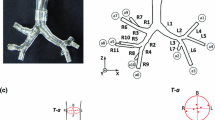Abstract
The single path model of airway gas transport was incorporated into each of the seven parallel regions model of Cruz (Cruz, J. C. Respir. Physiol. 86:1–14, 1991). Thus, the effect of time on the predicted gas fractions in and out of the lung could be evaluated. Two experimental maneuvers were simulated: (1) fast inhalation of an argon–oxygen mixture from a functional residual capacity and fast exhalation to residual volume, including inspiratory breath holdings of 5–20 s, and (2) the standard single-breath nitrogen washout test. Expired argon and nitrogen are predicted within a ±3% error of the experimental data with no breath holding. Breath holding predictions were at variance with experimental results because the solution of the diffusion-convection equation produced even mixing in the alveoli at the end of inspiration. The minimum square of the difference between the experimental data (standard single-breath nitrogen washout test) and those provided by the model was 0.0016. This model is capable of generating a nitrogen expirogram with four phases when a vital capacity of oxygen is inhaled. However, the model failed to produce a sharp distinction between phase 3 and phase 4. Thus, we conclude that uneven emptying of parallel regions generates any expirogram (a fast or slow expiratory maneuver). The alveolar gas stratification that is created during inspiration disappears at the end of the inspiratory maneuver. As a result, breath holding maneuvers cannot be predicted in the anatomical model used. © 2000 Biomedical Engineering Society.
PAC00: 8719Uv, 8710+e
Similar content being viewed by others
REFERENCES
1_ Anderson, D. A., J. C. Tannehill, and R. Pletcher. Computational Fluid Mechanics and Heat Transfer. New York: Hemisphere, 1984, pp. 138–160.
2_ Cruz, J. C.A combined parallel and series distribution model of inspired inert gases.Respir. Physiol.86:1-14, 1991.
3_ Cruz, J. C., and J. M. Mallea. Recalculation of Kaneko et al. model to predict the changes in the expired fraction of N2 at phase 4.Am. J. Respir. Crit. Care Med.155:A907, 1997.
4_ Cruz, J. C., D.-R. Jeng, D. Han, G. Wu, and X. F. Flores. Ventilation inhomogeneities and mixed venous blood N2 in multibreath N2 washout.Respir. Physiol.110:47-56, 1997.
5_ Flores, X. F., and J. C. Cruz. Slope of Phase IV, not the onset of phase IV, is related to the concentration difference between the apex and base of the lungs.FASEB J.6:A1476, 1992.
6_ Han, D., D.-R. Jeng, J. C. Cruz, X. F. Flores, and J. M. Mallea. New way of calculating the N2 evolution from blood in modeling multibreath inert gas washout.FASEB J.11:A473, 1997.
7_ Horsfield, K., and G. Cumming. Morphology of the bronchial tree in man.J. Appl. Physiol.24:373-383, 1968.
8_ Jeng, D.-R., D. C. Han, G. Wu, and J. C. Cruz. Argon expirograms: Effect of breath holding.FASEB J.12:A499, 1998.
9_ Kaneko, K., J. Mohler, and O. Balchum. Effect of preinspiratory lung volume on closing volume determination by nitrogen method.J. Appl. Physiol.38:10-15, 1975.
10_ Laviolette, M., and Y. Cormier. Intra versus interregional nitrogen gradients in the single breath nitrogen test.Respir. Physiol.41:267-277, 1980.
11_ Mallea, J. M., and J. C. Cruz. Improvement of Kaneko et al. model to predict the changes in the expired fraction of N2.Am. J. Respir. Crit. Care Med.155:A907, 1997.
12_ Martin, R., and P. T. Macklem. Suggested Standardized Procedures for Closing Volume Determinations (Nitrogen Method). Bethesda, MD: National Heart, Lung and Blood Institute, 1973.
13_ Milic-Emili, J., J. A. M. Henderson, M. B. Dolovich, and K. Kaneko. Regional distribution of inspired gas in the lung.J. Appl. Physiol.21:749-759, 1966.
14_ Paiva, M.Gas transport in the human lung.J. Appl. Physiol.25:401-410, 1973.
15_ Paiva, M., and L. A. Engel. Model analysis of gas distribution within the human lung acinus.J. Appl. Physiol.56:418-425, 1984.
16_ Scherer, P. W., L. H. Shendalman, and N. M. Green. Simultaneous diffusion and convection in single breath lung washout.Bull. Math. Biophys.34:393-412, 1972.
17_ Scherer, P. W., J. D. Neff, J. E. Baumgardner, and G. R. Neufeld. The importance of a source term in modeling multiplebreath inert gas washout.Respir. Physiol.103:99-103, 1996.
18_ Scherer, P. W., S. Gobran, S. J. Aukburg, J. E. Baumgardner, R. Bartkowski, and G. R. Neufeld. Numerical and experimental study of steady-state CO2 and inert gas washout.J. Appl. Physiol.64:1022-1029, 1988.
19_ Sikand, R., P. Cerretelli, and L. E. Farhi. Effects of VA and VA/Q distribution and of time on the alveolar plateau.J. Appl. Physiol.21:1331-1337, 1966.
20_ Six, D. P. J., W. R. de Vries, and S. C. M. Luijendijk. Alveolar sacs and expirograms of He and SF6: A model study.Comput. Biomed. Res.24:321-331, 1991.
21_ Six, D. P. J., W. R. de Vries, and S. C. M. Luijendijk. Collateral ventilation and the sloping alveolar plateaus of He and SF6: A model study.Respir. Physiol.90:145-158, 1992.
22_ Subramanian, K. Simulation of gas mixing in the human lung taking into account the expanding/contracting nature of the alveoli. The University of Toledo. Toledo, OH, MS thesis, 1998, pp. 36–40.
23_ Van Liew, H., and R. Arieli. Exchanges of oxygen and carbon dioxide alter inert gas pattern in single-breath tests.J. Appl. Physiol.50:487-492, 1981.
24_ Weibel, E. R. Morphometry of the Human Lung. Berlin: Springer, 1963, pp. 136–140.
25_ West, J. B.Regional differences in gas exchange in the lung of erect man.J. Appl. Physiol.17:893-898, 1962.
26_ Wu, G., D.-R. Jeng, and X. P. Flores. Convection–diffusion mechanism in a 7 region lung model.FASEB J.7:A230, 1993.
Author information
Authors and Affiliations
Rights and permissions
About this article
Cite this article
Jeng, DR., Wu, G., Cruz, J.C. et al. Diffusion-Convection Equation Solved in Parallel Regions of the Lung. Annals of Biomedical Engineering 28, 453–462 (2000). https://doi.org/10.1114/1.283
Issue Date:
DOI: https://doi.org/10.1114/1.283




